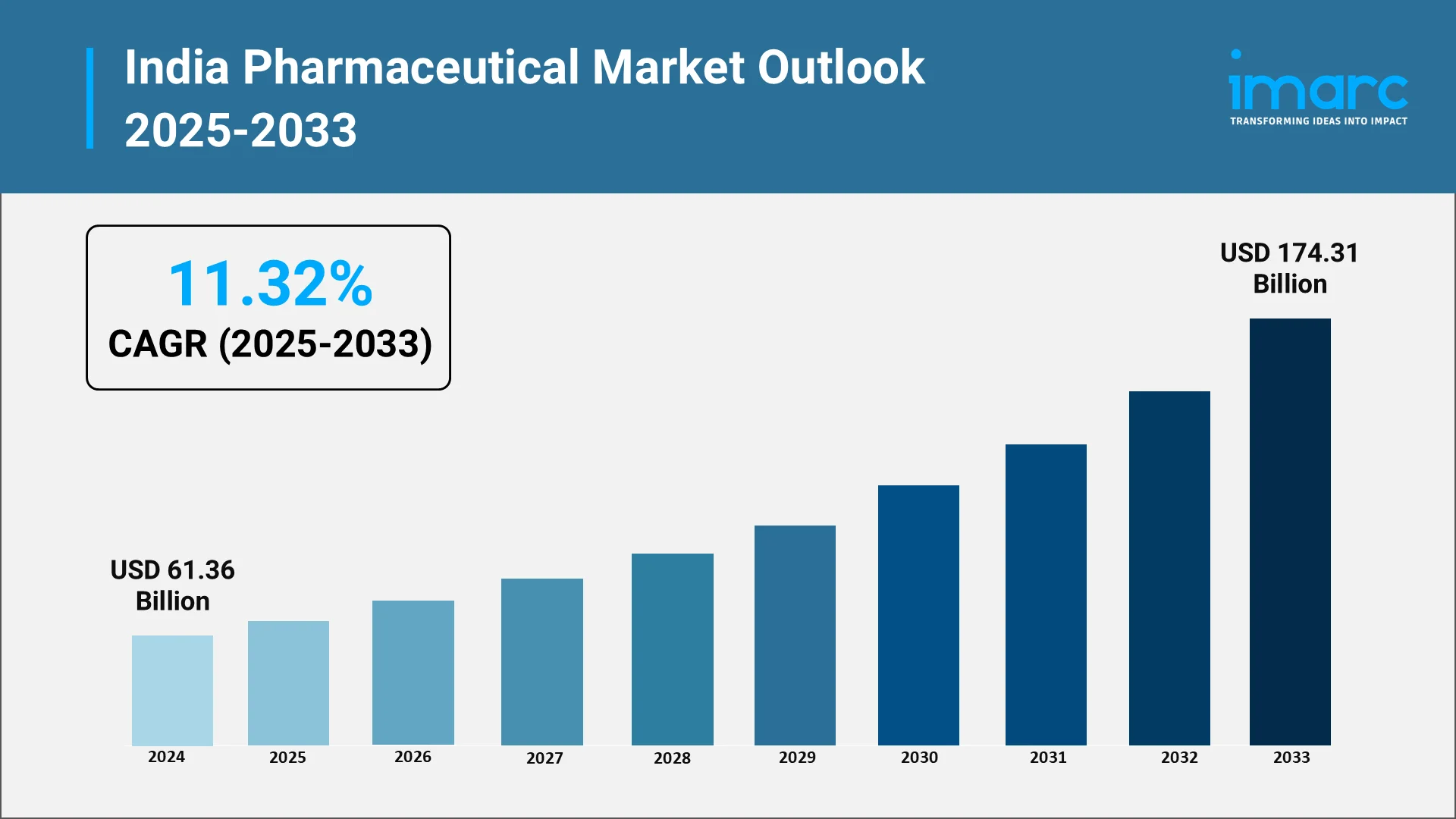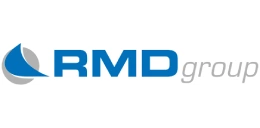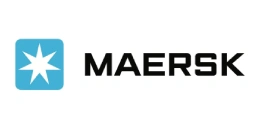How AI is Transforming India's Pharmaceutical Industry

India's pharmaceutical sector is evolving rapidly, supported by the integration of artificial intelligence (AI) across the value chain. As of 2023, India ranked as the third-largest pharmaceutical producer by volume, accounting for 20% of global generic drug exports. According to IMARC Group, the sector is projected to reach a market size of USD 174.31 Billion by 2033. This forecast is closely tied to how AI will improve operations across drug development, manufacturing, distribution, and healthcare delivery.

Explore in-depth findings for this market, Request Sample
Strategic Areas of AI Application
- Drug discovery and development
- Supply chain management
- Quality control systems
- Personalized healthcare
- Regulatory and safety compliance
The global market for AI in drug discovery stood at USD 1.8 Billion in 2024 and is expected to grow to USD 14 Billion by 2033, at a CAGR of 23.17%. In India, half of pharmaceutical firms are exploring GenAI proof-of-concept initiatives, with a quarter having implemented AI solutions in live production. Around 66% of healthcare providers are experimenting with AI in various capacities.
AI in Drug Discovery & Development: Accelerating Innovation
AI is changing how Indian companies approach R&D by accelerating the discovery of new drug candidates and reducing costs. Instead of relying solely on time-consuming lab experiments, AI platforms can scan massive datasets to identify promising compounds and predict their potential effectiveness.
Companies are investing in platforms that can virtually screen millions of molecules and model drug-target interactions with greater accuracy. Machine learning tools also analyze protein structures and genetic variations to generate therapeutic leads that may have been overlooked by traditional approaches.
A recent initiative in this space is the Center of Excellence for AI in Healthcare (AI-CoE), a collaboration between IIT Delhi and AIIMS Delhi launched in June 2025 with INR 330 crore in funding. The center is focused on developing indigenous AI solutions for improving healthcare access and outcomes, particularly in underserved communities.
India’s biotech startup scene has crossed 10,000 firms in 2025, many of which are working on AI-led drug discovery. Areas like oncology, infectious diseases, and neurology are seeing focused innovation aligned with the health needs of the local population.
Predictive Analytics for Demand Forecasting: Optimizing Market Response
Accurately forecasting pharmaceutical demand in India is challenging due to regional disease patterns, seasonal illnesses, and a large, diverse population. AI-driven predictive analytics is helping pharmaceutical firms refine inventory planning and production schedules.
By analyzing data from epidemiological reports, weather trends, regional demographics, and pharmacy sales, AI models generate forecasts that guide supply decisions. These insights are especially valuable in managing stock levels for essential medicines, where shortages can carry serious health consequences.
AI systems are also helping manufacturers prepare for demand spikes linked to seasonal illnesses like monsoon-related infections and winter respiratory diseases. Real-time data from hospitals, government sources, and pharmacy networks are being integrated to enhance accuracy.
For manufacturers and distributors, the result is a more adaptive supply chain—one that is better positioned to meet fluctuations in demand without excessive overstock or stockouts. This flexibility also reduces waste and lowers operational costs.
Personalized Treatment & Medicine Recommendations: The Future of Healthcare
Advancements in AI and genomics are laying the groundwork for individualized treatment strategies tailored to patient-specific factors such as genetics, lifestyle, and medical history. Indian pharmaceutical firms are beginning to implement AI-driven tools that assist in designing personalized therapies, selecting appropriate dosages, and flagging potential adverse reactions.
Some companies are partnering with hospitals and research institutions to build clinical decision support systems powered by AI. These platforms help doctors make more informed treatment choices and adjust protocols based on patient response patterns.
Recent examples include:
- MedMitra AI, a Jaipur-based healthtech firm, which raised INR 3 crore in funding to expand its AI-based platform for diagnosis and treatment planning.
- Apollo Cancer Centre in Bengaluru, which launched India’s first AI-Precision Oncology Centre. The facility integrates genomic, clinical, and pathological data to personalize cancer care and improve patient adherence through real-time monitoring.
These initiatives point toward broader applications, particularly in managing diseases such as diabetes, cardiovascular conditions, and cancers that have high prevalence in India. AI systems are helping identify population-specific genetic markers, enabling the development of treatments that are more effective for Indian patients.
AI in Supply Chain & Distribution: Ensuring Reliable Access
Managing the pharmaceutical supply chain in India requires navigating challenges that range from infrastructure gaps to climate variability. AI is increasingly being used to enhance logistics performance, ensure medicine availability, and reduce systemic inefficiencies.
Route optimization tools now incorporate live traffic, weather updates, and demand forecasts to design more efficient delivery paths. These systems help reduce transit times, lower fuel consumption, and ensure timely restocking in both urban and rural areas.
Cold chain monitoring is another critical area. AI-powered systems equipped with IoT sensors track temperature conditions during transport and storage, automatically flagging risks of spoilage for sensitive products like vaccines and biologics.
One notable example is Hospkart.com, launched by Hospkart Healthique Pvt Ltd. The platform serves as an AI-enabled B2B marketplace that connects hospitals and clinics with vetted suppliers, streamlining procurement of surgical instruments, diagnostic tools, and hospital infrastructure.
Inventory management is also improving through predictive analytics, which triggers automated reordering when stock reaches predefined thresholds. This reduces manual oversight while helping companies respond quickly to regional demand changes.
Quality Control & Defect Detection: Ensuring Safety and Compliance
Maintaining product safety and consistency is vital in pharmaceutical manufacturing, where even minor defects can compromise efficacy or patient health. AI-powered quality control systems are enhancing inspection accuracy, reducing human error, and supporting regulatory compliance.
Computer vision tools are now deployed on production lines to detect anomalies in tablet size, color, or texture. These systems outperform manual inspections in speed and reliability.
In packaging, AI verifies label accuracy, alignment, and print quality in real time, minimizing packaging defects and mitigating the risk of product recalls. Machine learning models are also being used for statistical process control, identifying early signs of deviation before they escalate.
Predictive maintenance is another emerging area. By monitoring equipment performance metrics, AI systems can anticipate failures and schedule timely interventions, reducing downtime and preserving batch integrity.
An illustrative example is GE HealthCare’s OnWatch Predict, which monitors MRI equipment and has reportedly reduced unplanned downtime by up to 40%, increasing scanner availability across healthcare facilities.
AI Chatbots for Patient & Doctor Engagement: Enhancing Communication
AI-powered chatbots are playing a growing role in bridging communication gaps between pharmaceutical companies, healthcare providers, and patients. These systems offer on-demand assistance with medical queries, drug information, adverse event reporting, and therapy adherence, especially in time-constrained clinical settings.
For clinicians, chatbots serve as quick-reference tools. They provide access to drug databases, dosage guidelines, interaction warnings, and clinical trial summaries. Patients benefit from language-friendly interfaces that deliver instructions, address concerns about side effects, and help manage treatment schedules.
One example is CureBay, a rural healthcare platform that operates over 150 eClinics combining AI, IoT diagnostics, and hybrid care models. The company raised $21 million in Series B funding in 2025 to expand across underserved Indian states. Their AI systems support timely care coordination and improve access in low-resource regions.
Chatbots are also being used to gather real-world data from patients. Feedback about drug outcomes, adherence levels, and symptom progression contributes to post-market surveillance and continuous improvement of therapies.
Promoting Sustainability with AI: Environmental Responsibility
AI is also becoming a key enabler of sustainability in the pharmaceutical sector. Companies are using AI systems to monitor and reduce energy consumption, optimize water usage, and minimize chemical waste during manufacturing.
AI tools analyze equipment efficiency, production scheduling, and environmental data to identify where utilities can be conserved without compromising throughput. These systems can automatically adjust operations to run at lower energy loads during off-peak hours or reduce unnecessary heating and cooling cycles.
In water-intensive processes, AI helps track consumption, detect leaks, and identify opportunities for recycling. Similarly, waste reduction is being achieved through real-time monitoring of reaction conditions and raw material utilization.
A relevant case is Merck’s modular GMP manufacturing line, developed with Siemens and supported by Germany’s Economic and Climate Ministry. This system uses AI to enable flexible and energy-efficient drug production, cutting emissions and utility costs while maintaining high regulatory compliance.
As sustainability reporting becomes more rigorous, AI-supported tracking and forecasting tools are helping Indian pharmaceutical firms quantify their carbon footprint and improve compliance with environmental regulations.
Market Size and Growth Projections: A Data-Driven Outlook
India Active Pharmaceutical Ingredients Market
The India active pharmaceutical ingredients (API) market size was valued at USD 17.77 Billion and is projected to reach USD 38.60 Billion by 2033, growing at a CAGR of 8.10% during 2025-2033. This robust growth trajectory reflects India's strengthening position as a global API manufacturing hub, supported by government initiatives like the Production Linked Incentive (PLI) scheme and increasing investments in domestic manufacturing capabilities.
The API market's expansion is being driven by rising global demand for cost-effective pharmaceutical ingredients, India's established manufacturing expertise, and the ongoing trend toward supply chain diversification following global disruptions. AI technologies are playing an increasingly important role in optimizing API manufacturing processes, improving yield rates, and ensuring consistent quality standards that meet international regulatory requirements.
India Pharmaceutical Manufacturing Market
The pharmaceutical manufacturing sector in India represents the backbone of the country's pharmaceutical industry, encompassing both domestic formulation manufacturing and contract manufacturing for global clients. In 2024, the India pharmaceutical manufacturing market reached USD 19.25 Billion and is expected to grow to USD 35.13 Billion by 2033, exhibiting a CAGR of 6.91% during 2025-2033. The market is experiencing strong growth driven by increasing domestic demand, expanding export opportunities, and technological modernization of manufacturing facilities.
AI integration in manufacturing processes is enabling Indian companies to achieve higher efficiency levels, reduce production costs, and maintain quality standards that compete with global benchmarks. Smart manufacturing initiatives incorporating AI, IoT, and automation technologies are becoming increasingly common across the industry.
India Pharmaceutical Filtration Market
The pharmaceutical filtration market is a specialized segment that supports the broader pharmaceutical manufacturing industry by providing critical separation and purification technologies. In 2024, the India pharmaceutical filtration market was valued at USD 818.6 Million and is anticipated to reach USD 1,606.6 Million by 2033, registering a CAGR of 7.22% from 2025 to 2033. This market is growing in line with overall pharmaceutical production expansion and increasing quality standards for pharmaceutical products.
AI-powered filtration systems are improving process efficiency and product quality while reducing operational costs. Predictive maintenance algorithms help optimize filter performance and reduce unplanned downtime, contributing to more reliable pharmaceutical manufacturing operations.
India Generic Drugs Market
India's generic drugs market represents one of the country's greatest pharmaceutical success stories, with Indian companies supplying affordable generic medications to both domestic and international markets. The India generic drugs market stood at USD 28.06 Billion in 2024, and is projected to reach USD 51.47 Billion by 2033, reflecting a CAGR of 6.97% during 2025-2033. The market continues to grow driven by patent expirations of branded drugs, increasing healthcare access initiatives, and cost-containment pressures in global healthcare systems.
AI technologies are helping generic drug manufacturers optimize their product portfolios, improve manufacturing efficiency, and accelerate regulatory approval processes. Predictive analytics help companies identify promising generic opportunities and optimize market entry strategies.
India Biosimilar Market
The biosimilars market in India is expected to grow at a CAGR of 17.38% from 2025 to 2033, reaching USD 3,662.9 Million by 2033. This exceptional growth rate reflects the increasing adoption of biosimilar products as cost-effective alternatives to expensive biologic drugs.
AI is playing a crucial role in biosimilar development by accelerating comparative studies, optimizing manufacturing processes, and supporting regulatory submissions. The complexity of biosimilar development makes AI-powered analytical tools particularly valuable for Indian companies seeking to establish strong positions in this high-growth market segment.
Future Outlook: AI as a Strategic Imperative
AI is becoming a strategic necessity for Indian pharmaceutical companies, not just a technology upgrade. More than 85% of biopharma executives surveyed in 2025 reported active investments in AI and digital tools, particularly to enhance supply chain resilience and accelerate innovation.
The industry is moving toward end-to-end AI integration—from early-stage research to post-market surveillance. Indian firms are beginning to explore AI-native models that build digital tools into their business architecture rather than retrofitting legacy systems. Public-private partnerships are also gaining momentum, driving AI development for national health priorities.
Investment in AI talent, infrastructure, and regulatory engagement is expected to grow. Indian regulatory authorities are adapting existing frameworks to include AI-based tools in pharmaceutical development, which will help streamline approvals and encourage further innovation.
Companies that prioritize AI implementation across the pharmaceutical value chain are more likely to gain a competitive edge in both domestic and global markets.
How IMARC Group Empowers Pharmaceutical Companies in the AI Transformation
As Indian pharmaceutical companies embrace AI, IMARC Group provides the research and strategic insight needed to support effective decision-making. We work with clients across the value chain, from manufacturers and biotech startups to investors and technology providers.
Our services include:
- Market sizing, forecasting, and segmentation
- Competitive benchmarking and positioning
- Technology impact assessment and adoption strategy
- Regulatory landscape analysis
- Partnership and investment due diligence
With deep expertise in both pharmaceutical operations and emerging AI technologies, IMARC helps stakeholders identify opportunities, assess risks, and navigate the evolving landscape.
Whether the goal is accelerating drug development, optimizing operations, or expanding market access, our support ensures organizations are equipped to respond confidently to industry shifts.
Our Clients
Contact Us
Have a question or need assistance?
Please complete the form with your inquiry or reach out to us at
Phone Number
+91-120-433-0800+1-201-971-6302
+44-753-714-6104
-(1)_11zon.webp)










